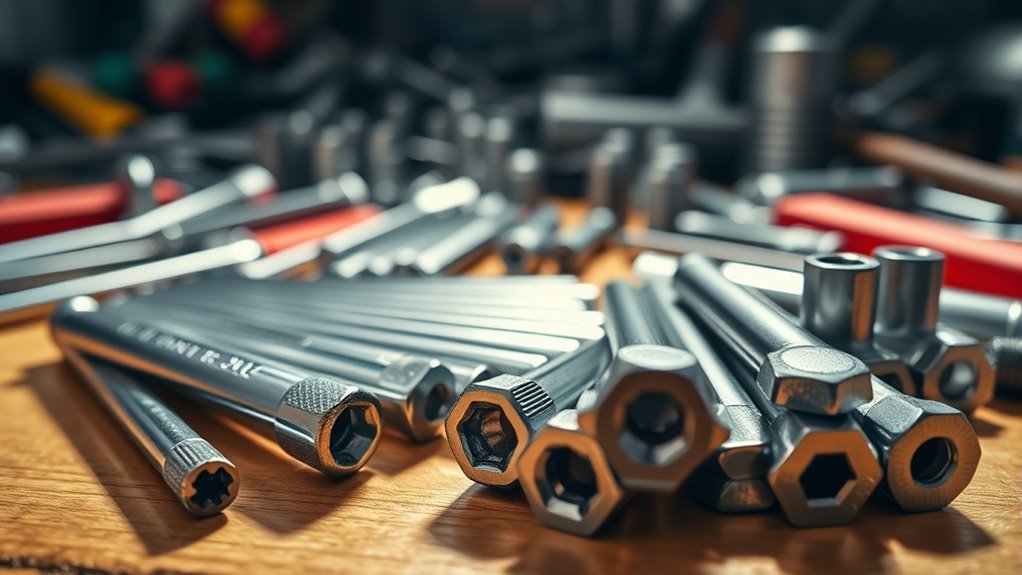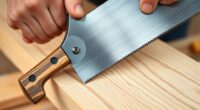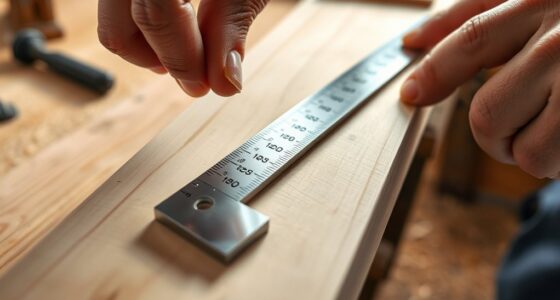Use Allen keys when working with fasteners that have hexagonal sockets, common in furniture assembly, bicycles, and machinery. Opt for Torx keys when dealing with star-shaped fasteners, often found in automotive and electronics applications, especially where high torque is needed or to prevent cam-out. Choosing the right tool guarantees safety and efficiency. If you’re curious about specific situations for each, the details ahead will guide you in making the best choice.
Key Takeaways
- Use Allen keys for fasteners with hexagonal socket heads, common in furniture and bicycle repairs.
- Use Torx keys for star-shaped fasteners requiring high torque, typical in automotive and electronics assembly.
- Choose Allen keys for general, standard fasteners needing quick access and straightforward storage.
- Opt for Torx keys when working with fasteners that need secure grip and resistance to cam-out.
- Select the tool based on fastener type, industry application, and the required torque to ensure safety and efficiency.
Understanding the Different Types of Fasteners
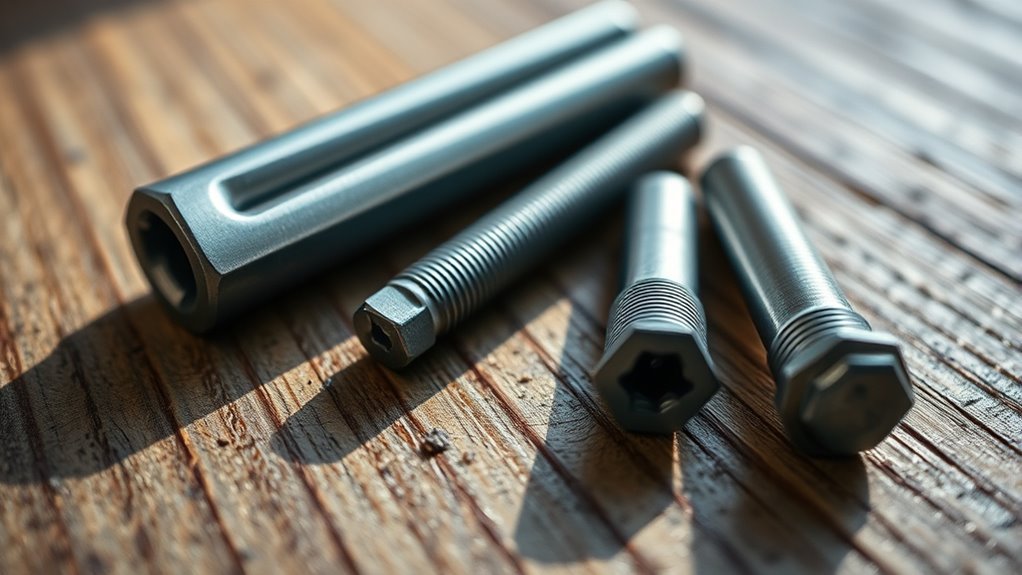
To effectively work with fasteners, mastering the different types you’ll encounter is essential. When dealing with decorative hardware or furniture assembly, you’ll notice a variety of fasteners designed for specific purposes. Some fasteners have unique heads to enhance aesthetics or prevent tampering, which impacts the tools you’ll need. For example, decorative hardware often uses specialized fasteners to blend seamlessly with furniture design, requiring precise tools. Understanding these differences helps you choose the right fastener for each task, ensuring a secure fit and polished look. Recognizing the various fastener types also prevents damage to delicate surfaces or hardware. By familiarizing yourself with common fastener designs, you’ll streamline your work and achieve professional results in all your projects. Bedroom design elements can also influence the choice of fasteners, ensuring they complement the overall aesthetic.
Recognizing the Design and Shape of Allen and Torx Keys
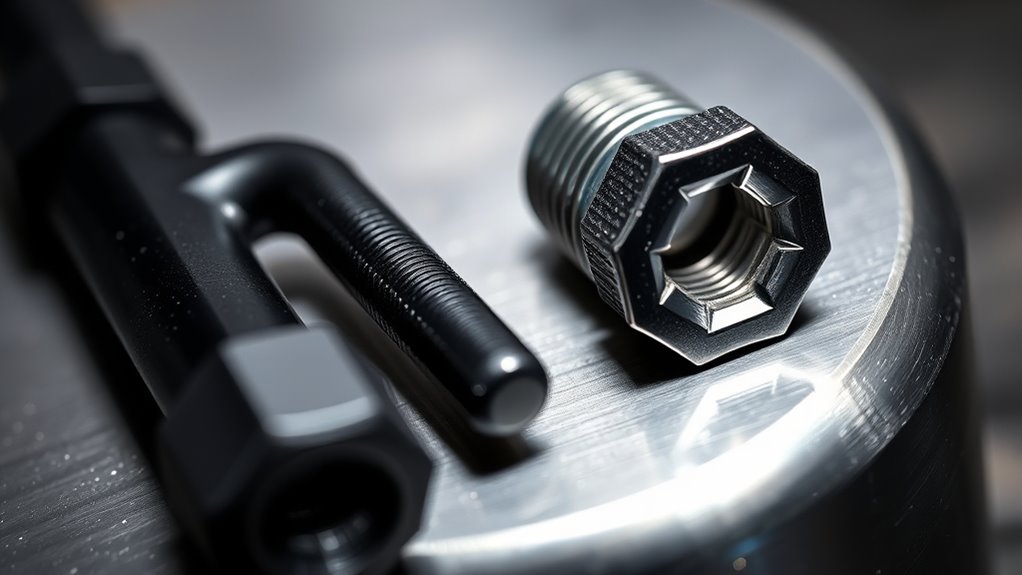
Allen keys and Torx keys each have distinct shapes that make them easily recognizable. Allen keys are L-shaped with a simple hexagonal profile, offering an ergonomic design that fits comfortably in your hand for better torque. Their shape is straightforward, making them easy to identify quickly. Torx keys, on the other hand, feature a star-shaped tip with six rounded points, designed to provide a secure grip and reduce slippage. Many sets incorporate color coding on the handles or tips to help you distinguish between sizes at a glance. Recognizing these differences in shape and design allows you to select the right tool efficiently, ensuring proper fit and reducing the risk of damaging fasteners. Understanding these visual cues saves you time and enhances your overall toolkit organization. Additionally, the design differences of these tools are tailored to specific applications, which can influence their effectiveness and longevity.
Common Applications for Allen Keys

Allen keys are highly versatile tools popular for their simplicity and ease of use. You’ll often find them in furniture assembly, bicycle maintenance, and machinery repairs. Their ergonomic design allows for comfortable grip and torque application, making tasks easier and reducing hand fatigue. Because they adhere to strict manufacturing standards, Allen keys provide consistent fit and reliable performance across various applications. You might use them to tighten hexagonal socket screws in flat-pack furniture or secure components in bicycles and electronics. Their straightforward design makes them ideal for situations requiring precise torque without slipping. Whether working on home projects or professional tasks, Allen keys are your go-to tool when you need a reliable, ergonomic solution for fastener tightening and adjustment. Self Watering Plant Pots are an example of everyday items that benefit from precise assembly and maintenance, often requiring tools like Allen keys for proper setup.
Typical Uses for Torx Keys
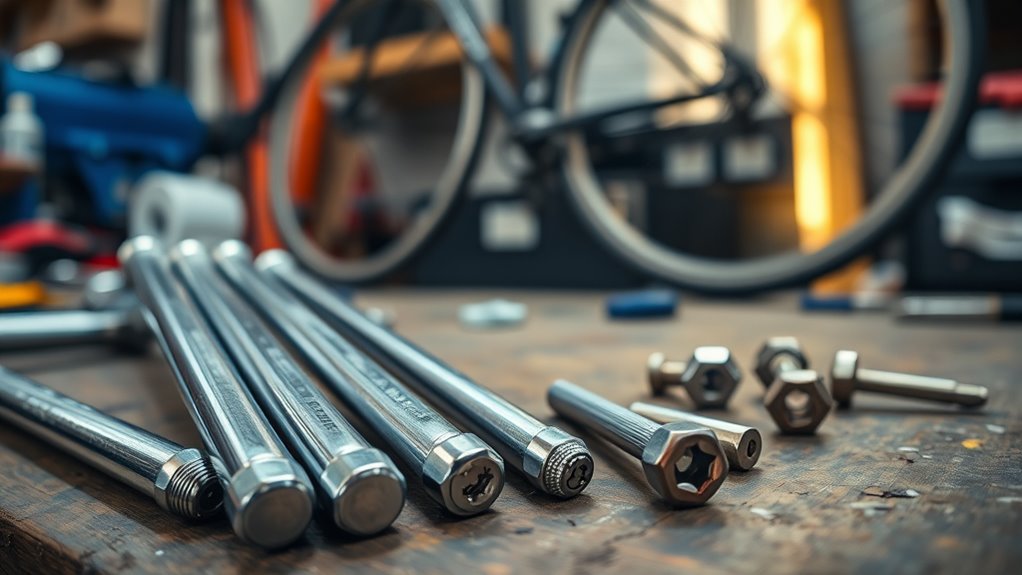
You’ll find Torx keys commonly used in automotive fasteners, where their design helps prevent cam-out and provides extra torque. They’re also essential in electronics assembly, offering secure connections in tight spaces. Understanding these typical applications can help you choose the right tool for the job.
Automotive Fasteners
In automotive maintenance, Torx keys are essential tools for handling fasteners that require high torque and resistance to cam-out. You’ll often find them securing wheel hubs, brake components, and engine parts. Using Torx keys ensures a secure fit, reducing stripped fasteners and damage. Their design allows you to apply greater torque safely, making repairs quicker and more efficient. When selecting tools, consider ergonomic design features that provide comfort during extended use. Proper tool storage keeps your Torx keys organized and easily accessible, preventing loss and damage. This setup streamlines your workflow, especially when working on vehicles with numerous fasteners. Overall, Torx keys are invaluable for automotive fasteners, offering durability, precision, and comfort for professional and DIY car repairs alike. Additionally, choosing high-quality tools can enhance your efficiency and safety during maintenance tasks.
Electronics Assembly
Torx keys are commonly used in electronics assembly to secure components that require high torque and a precise fit. They’re essential for ensuring your devices stay reliable and safe. When working with electronics, using the right tool improves ergonomic design, reducing hand fatigue during long projects. Plus, incorporating proper tool storage solutions keeps your Torx keys organized and accessible. Here are three reasons you’ll love using Torx keys in electronics assembly:
- They prevent slipping, protecting delicate components.
- They deliver consistent torque, ensuring secure fastening.
- They streamline your workflow, saving time and frustration.
Compatibility and Accessibility of Each Tool
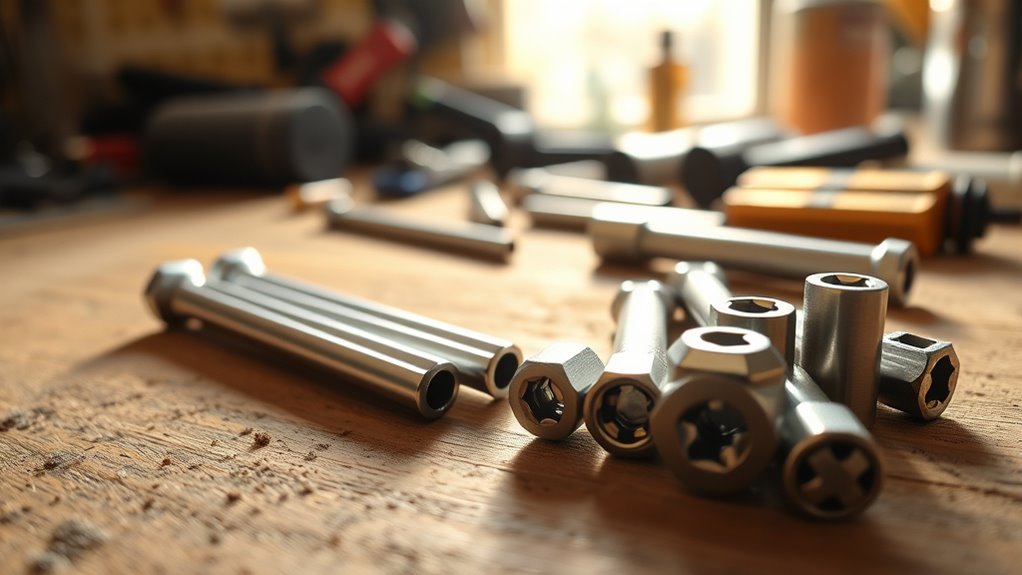
While both Allen keys and Torx keys are widely used for fastening tasks, their compatibility and accessibility vary depending on the application. Allen keys are common in furniture and bicycle repairs, often stored in compact tool sets, making tool storage straightforward. Torx keys are prevalent in automotive and electronics assembly, where specialized fasteners are common. Their ergonomic design influences ease of use, especially during prolonged tasks. Consider this comparison:
| Tool Compatibility | Accessibility | Ergonomic Design |
|---|---|---|
| Allen keys fit many standard hex fasteners | Easily stored in compact sets | Straight, simple handle design |
| Torx keys require specific fasteners | Often stored separately for specialized tasks | T-shaped design offers better grip |
Choosing the right tool depends on your need for compatibility and ease of access. Additionally, understanding the fastener types used in various industries can help you select the most suitable tool for your projects.
Safety and Performance Considerations When Choosing Between Them

When choosing between Allen and Torx keys, safety and performance should be your top priorities. A proper fit reduces slips and strips, preventing damage and injuries. Consider material durability and compatibility to make certain reliable, long-lasting performance in your projects. Additionally, understanding the specific project requirements and how each tool interacts with different fasteners can help optimize your work quality.
Reduced Slips and Strips
Choosing the right tool can considerably reduce slips and strips during use, enhancing both safety and performance. When selecting between Allen and Torx keys, consider how grip enhancement and tool longevity come into play. A secure grip minimizes the risk of slipping, protecting you from injury and damaging fasteners. Proper fit also prolongs tool life, preventing wear and tear that lead to stripping.
To maximize safety and efficiency:
- Prioritize tools with textured handles for better grip.
- Choose tools made from durable materials that resist stripping.
- Ensure the tool fits snugly into fasteners to prevent slips.
Proper Fit for Fasteners
A proper fit between your tool and fastener is essential for safe and effective work. When choosing between Allen keys and Torx keys, ensure the tool snugly fits the fastener head. An ergonomic grip helps maintain control, reducing the risk of slips that can cause injury or damage. A well-fitting tool minimizes the chance of stripping the fastener, saving time and frustration. Consider storage solutions that keep your tools organized by size and type to quickly find the right fit when needed. Properly fitting tools also promote better torque transfer, improving performance and prolonging the life of both the fastener and tool. Verifying compatibility with the fastener head type is crucial to prevent accidents and ensure your work is efficient, safe, and of high quality. Additionally, understanding the specific fastener types used in performance upgrades can help you select the most appropriate tools for your Honda tuning projects.
Material Compatibility and Durability
Material compatibility and durability are crucial factors that influence both safety and performance when selecting Allen or Torx keys. Your choice depends on how well the tool withstands stress and environmental factors. Consider these points:
- Material strength: A strong material ensures the key won’t bend or break under pressure, preventing accidents.
- Corrosion resistance: Tools resistant to rust last longer, especially in humid or corrosive environments, maintaining safety.
- Long-term reliability: Durable keys maintain their shape and grip, reducing the risk of slipping or damaging fasteners over time.
- Proper material selection can also prevent the tool from wearing out quickly, ensuring consistent performance and safety.
Choosing the right material for your application guarantees safety, maximizes performance, and extends your tools’ lifespan. Don’t compromise on endurance—your safety depends on it.
Frequently Asked Questions
Are Allen and Torx Keys Interchangeable for Similar Fasteners?
You can’t use Allen and Torx keys interchangeably because of fastener compatibility issues. Allen keys fit hexagonal sockets, while Torx keys match star-shaped fasteners. Using the wrong tool can strip the fastener or damage the tool, diminishing tool versatility and effectiveness. Always select the correct key type to ensure a secure fit, better grip, and to avoid damaging your fasteners or tools during assembly or repair.
How Do I Identify the Correct Size of Allen or Torx Key?
To identify the correct size of an allen or torx key, you should use a measuring tool like a caliper or a ruler to compare the key’s width or diameter. Look closely at the fastener marking or the key itself for size indicators, which are often stamped or engraved. Matching the measurement precisely guarantees a secure fit, preventing damage to the fastener or tool. Always double-check before applying force.
Can Using the Wrong Key Damage the Fastener or Tool?
Using the wrong key can cause fastener damage and compromise tool safety. When you force a too-small Allen or Torx key into a fastener, you risk stripping the fastener’s head, making future removal difficult. Using an improper size increases tool wear and potential breakage, risking injury. Always select the correct size to guarantee a secure fit, protect your tools, and maintain the integrity of your fasteners.
Which Key Type Offers Better Torque for Heavy-Duty Tasks?
For heavy-duty tasks, Torx keys generally offer better torque because their design distributes force more evenly, reducing the risk of stripping. The material strength of the tool is vital, and Torx tools often feature stronger, more durable construction. Additionally, ergonomic design allows you to apply maximum force comfortably, making Torx keys a better choice when tackling high-torque, demanding jobs.
Are There Any Specific Maintenance Tips for Prolonging Tool Lifespan?
To prolong your tools’ lifespan, you should focus on proper storage and regular cleaning. Store your Allen and Torx keys in a dry, organized place to prevent rust and damage. After each use, clean off dirt and debris to maintain their effectiveness. Regularly inspect for wear or damage, and lubricate moving parts if needed. These simple steps help keep your tools in top shape, ensuring they’re ready whenever you need them.
Conclusion
Choosing between Allen and Torx keys depends on the task at hand, just like selecting the right tool for the right job. Think of them as different keys to open your project’s success—each with its own strengths. By understanding their unique shapes and applications, you guarantee safety, efficiency, and a job well done. So, next time you’re faced with a fastener, remember: the right key can make all the difference in turning a challenge into an easy win.
